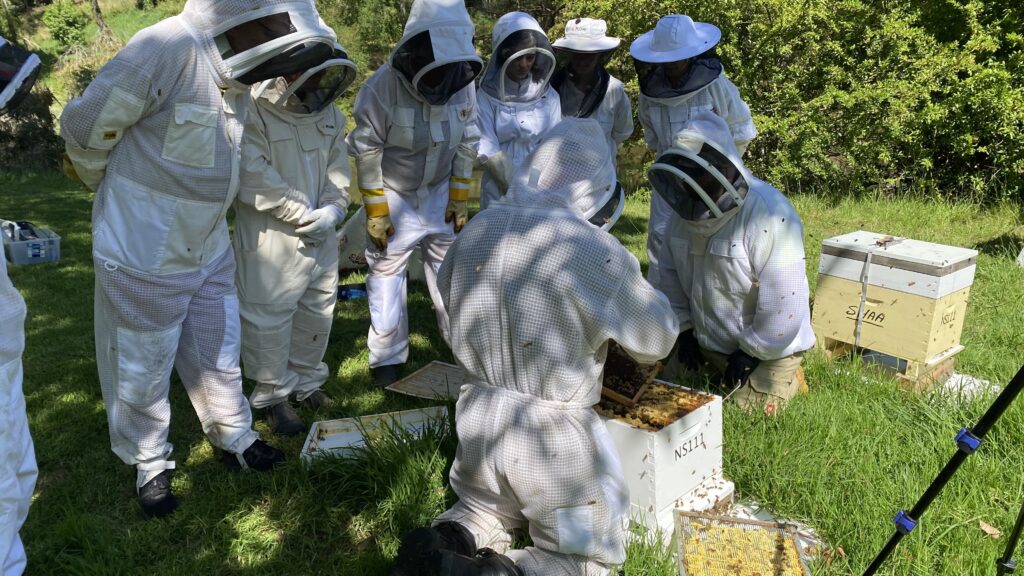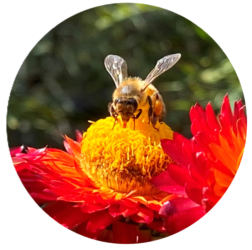A seasonal calendar to describe hive activity along with suggested beekeeper actions each month.
| Month | Hive Activity | Beekeeper Actions |
|---|---|---|
| July | Egg production is starting to increase, brood nest starting to grow, resulting in growing colony – in preparation for spring. | Check hives only from outside, keep entrance clear of grass, weeds, and other obstacles. Prepare boxes, frames, lids, and equipment for next season. Do not open the hive for inspection of frames during winter. Update your logbook. |
| August | Egg production is slowly increasing, brood nest growing, resulting in a growing colony – in preparation for spring. Bees may start raising drones then queen cells in preparation for swarming. | Check hives only from outside, keep entrance clear of grass, weeds and other obstacles. Prepare boxes, frames and equipment for next season. Plan a brood inspection for diseases AFB, EFB, Chalkbrood, Nosema and a Varroa mite inspection schedule every 16 weeks. Only if weather permits, perform your first pest (Varroa, wax moth small hive beetle), update the DPI, and perform a disease check (AFB, EFB, Chalkbrood, Nosema). Plan future activities based upon your observations. Update your logbook. Do not open the hive for inspection of frames during cold weather. |
| September | Egg production increases: brood nest is growing further, resulting in growing bee numbers. Likelihood of bees raising queen cells in preparation for swarming increases. | When weather permits, inspect hives in 9–14-day intervals for queen cells and prevent swarming. Cycle out 2 – 4 old brood frames. Perform brood inspection for diseases AFB, EFB, Chalkbrood, Nosema If not done in August perform your Varroa mite surveillance, update the DPI. First chance to buy a queen to requeen your colony. Update your logbook. More bee activity at the entrance on warm days indicate growing colony. Warmer weather and increase in nectar and pollen will trigger swarming instinct. Queens are available from queen breeders from September until end of February. |
| October | Egg production is increasing and the brood nest is growing. Likelihood of bees raising queen cells in preparation for swarming is at its peak. Increasing number of drones at the hive entrance is a good indicator for swarm preparations. | When weather permits, inspect hives in 9-14-day intervals for queen cells, update your beekeeper’s logbook. If necessary, add a super to provide bees with space to build combs and store, this helps prevent swarming. If not completed in September, perform a brood pest inspection for diseases AFB, EFB, Chalkbrood, Nosema. NSW DPI AFB Awareness Month so – INSPECT, TEST, NOTIFY and ACT. |
| November | Egg production at peak; brood nest growing further, resulting in growing bee numbers. Likelihood of bees raising queen cells in preparation for swarming is at its peak if they have not swarmed already. Southern highlands swarms often start last week in September. | When weather permits, inspect hives in 9-14-day intervals for queen cells and prevent swarming, update your beekeeper’s logbook. If necessary (large bee population working all frames), stack a super on, providing bees with space to build combs and store. Collect honey surplus if available. |
| December | Egg production is at its peak, maintaining large brood nest, resulting in growing bee numbers. Likelihood of bees raising queen cells in preparation for swarming now decreases. | When weather permits, inspect hives in 3-6-week intervals, update your logbook. If not already completed perform your next Varroa surveillance check, update the DPI. If necessary (large bee population working all frames), stack a super on, providing bees with space to build combs and store. Collect honey surplus if available. Warm weather and abundance of nectar and pollen are good conditions for raising new colonies. |
| January | Egg production is at peak, maintaining large brood nest, resulting in growing bee numbers. Likelihood of bees raising queen cells in preparation for swarming decreases. | When weather permits, inspect hives in 3-6-week intervals, update your logbook. If necessary (large bee population working all frames, nectar flow is present), stack a super on, providing bees with space to build combs and store. Collect honey surplus if available. |
| February | Egg production is at peak, maintaining large brood nest, and large bee numbers. Likelihood of bees raising queen cells in preparation for swarming continues to decrease. | When weather permits, inspect hives in 3-6-week intervals, update your logbook. If necessary (large bee population working all frames, nectar flow is present), stack a super on, providing bees with space to build combs and store. Collect honey surplus if available. Last chance to buy a queen to requeen your colony. |
| March | Egg production reduces; reducing brood nest, reducing bee numbers. Worker bees start forcing almost all drones out of the hive. | Last thorough inspection of hives for health issues, update your logbook. Collect honey surplus if available. Start hive close-down for winter; compact bees into one or two boxes with sufficient winter stores. Occasionally tiny swarms still occur – they have little chance to survive without assistance. March can be a bit tricky – autumn crops like Grey box Eucalypts can be in full blossom and bees are producing great honey, sometimes until May/June. Harvest or hive close-down? – it depends on the weather conditions. |
| April | Egg production reduces further, reducing the brood nest and bee numbers. Worker bees force almost all drones out of the hive. | Collect honey surplus if available. If not already completed perform your next Varroa surveillance check, update the DPI and your logbook. Complete hive close-down for winter, compact bees into one or two boxes with sufficient winter stores. Feeding of sugar syrup (2-1) as required if the bees are active. Some keepers recommend placing dry sugar in feeders placed under the hive lid. Local advice is after ANZAC day, it is generally too cold to open hives for inspecting. |
| May | Egg production reaches minimum; maintaining small brood nest, and small bee numbers | Check hives only from outside, keep entrance clear of grass, weeds, and other obstacles, update your logbook. Prepare boxes, frames, and equipment for next season. Update your logbook. |
| June | Egg production is at a minimum, maintaining a small brood nest with small bee numbers. | Check hives only from outside, keep entrance clear of grass, weeds, and other obstacles. Prepare boxes, frames, and equipment for next season. Do not open the hive for inspection of frames during winter. If feeding use 2-1 sugar syrup or dry sugar in the top of the hive. Update your logbook. |


